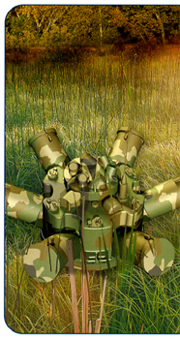|
Munition
Control Unit (MCU)
The MCU has a pedestal base with a built-in communications module
and connectors for up to six lethal or non-lethal devices. On operator
command, it autonomously deploys trip wires corresponding to the
six-launch azimuths of the grenades, which can be individually launched
outward from its base to intercept intruders.
Each of the six ports can be equipped with a grenade or replaced
with a connector that enables the on-command operation of other
ordnance — both lethal (such as hand-emplaced M18 Claymores)
and non-lethal.
The replaceable battery provides the MCU a field life in excess
of 30 days, during which it can communicate with an operator either
directly or through a field relay, or self-neutralize on command.
The MCU can be safely and rapidly recovered, reloaded and relaid.
Remote
Control Unit (RCU)
The RCU is a standard rugged laptop computer, equipped with a touch-screen
that provides man-in-the-loop (MITL) control of MCUs in the field.
Its communications module covers a range of 1,500 meters, and enables
the operator to command the launch of individual or collections
of grenades or other connected lethal or non-lethal ordnance.
Repeater
Units
Communications repeater modules can be placed between the RCUs and
the MCUs to extend the effective communications range of the system.
The repeater maintains communication with the multiple MCUs in the
field as well as the RCU used by the operator.
Rapid and
Safe Deployability, Recovery, Reload and Redeployability
Imagine the following battlefield scenario:
MCUs are hand emplace and oriented appropriately. Tactics, techniques
and procedures (TTP) provide appropriate densities and laydowns
to accomplish various tactical objectives. When all of the MCU locations
have been loaded into the RCU, the operator is able to "fight
the field".
When ready for final use, the operator remotely commands the deployment
of the six automatic trip wires. When a trip wire is pulled, a signal
is sent from the sensing MCU to the RCU. Based on that signal, the
operator's own observation of the field, and on other situational
awareness and guidance from the chain of command, the operator may
direct the detonation of the grenade(s) associated with the trip
wire detection. The operator can choose to allow a number of intruders
to penetrate further into the field to execute a delayed ambush
of multiple MCU grenades, or position a Claymore to cover a series
of MCUs. No munition is detonated except on command of an MITL operator.
Following the engagement, every MCU can be safely recovered. The
soldier quickly removes the expended trip wire container and checks
the remaining power in the battery. At the resupply truck, the soldier
replaces any expended grenade and trip wire canisters and draws
new batteries as required, allowing the MCU to be rapidly employed
again.
|

Spider's launch-on-command design allows
safe and rapid deployment, recovery, reload and redeployment,
as well as immediate harmless friendly passage or counter-attack. |
|

